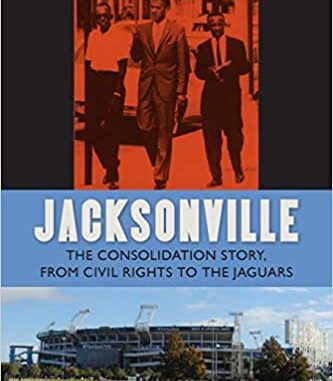
By Jasmine Butler – In a detailed and strategic publication, author James B. Crooks, takes his readers on the journey of how Jacksonville, Florida has changed and solidified since the 1960s.
As mentioned on the back cover, he focuses on 3 major issues, “Racial relations, environmental pollution, and the revitalization of downtown.”
The book recalls specific details about how downtown looked and transformed before and after consolidation. Overtime, there were many buildings and new additions being added to the downtown area. This included the Atlantic Coast Line Railroad home office, a new city hall, jail, courthouse, and new roadways. It tells about the former mayor, W. Haydon Burns and his efforts to renew the look and culture of Jacksonville during that time. He secured a heap of funding to do this and eventually lived up to his personal vision, “A city builder.”
The text also goes into detail about an influential organization in Jacksonville, The Chamber of Commerce. They focused on public education, public health, port development, and transportation.
“Perhaps the most important factor influencing Jacksonville’s growth was the Chamber of Commerce. It strongly supported the development of the expressway system, renewal of downtown, and the relocation of insurance businesses to the city,” Crooks wrote.
The Chamber of Commerce had the support of the city and Florida Legislature when it came to putting ideas and reforms underway.
Race relations played a huge role in the consolidation of Jacksonville. Crooks writes about Mayors and city leaders working toward improving minority communities and voting African- American leaders into office.
One thing that stood out was the effort to improve black communities. The root issue in most cases, as stated in the book, was the lack of employment. To summarize, they looked into the application and hiring pipeline and realized exactly why the problem was taking place and how it could be solved.
There were many African Americans voted into leadership positions during this time to represent their communities. This includes Sally Mathis and Mary Singleton, the first African Americans elected to city council since 1907.
Throughout the book, a recurring idea was that leaders needed to have solid representatives of the African American community in order to make a true change in race relations. The list of changes consisted of rent supplement housing, improved public transportation, recreational programs, improved drainage, and even a new high school in the underserved communities at the time.
Many riots and protests took place to fight for equality and improvements in the black community during that time. Among many organizations and leaders, one that truly made an impact was the Black Community Coalition. The book includes evidence and records of police brutality and unfair treatment toward African Americans that they used to fight for justice.
One statement reads, “On June 17, Eugene Soloman, deacon in the Unity of Faith Spiritual Church, was participating in a religious service at his church. ‘Police officers in riot helmets and shot-guns drawn rushed in the door and bodily took me from church,’ he wrote. After arresting him, police threw a tear gas container into the sanctuary, closed the door, and departed.”
The latter chapters of the book are organized by mayors that served during that time, “The Godbold years, The Hazouri years, and The Austin years.” Each mayor brought something different to the city of Jacksonville and helped to aid in the consolodation of the city.
Crooks ends the book by giving an overview of how Jacksonville looked and continued to evolve post consolidation. There are mentions of seminars and confrences that were used to educate the public and continue to make changes in the community. It continues to talk about funding, taxes, continuous racial inequality, structure, environmental pollution, voting, segregation, government, and community leaders.
This book definitely dives deep into the history and evolution of Jacksonville. It is a must-read for Jacksonville residents and those that find interest in how our city has changed. It includes detailed research and in-depth study of the many phases of the progressing town.

Be the first to comment